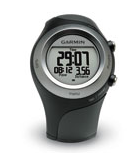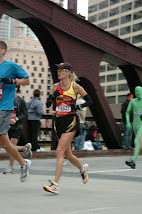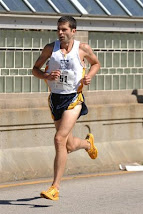
 A brisk walk as my whole family traipsed out... and we nearly got arrested for crossing the rail road tracks at the wrong spot. I wasn't sure if I should hold my knuckles out to get rapped with a ruler or go put my nose in the corner for ten minutes after that scolding. Arriving very early, we sat around for some time before I started my warm up.
A brisk walk as my whole family traipsed out... and we nearly got arrested for crossing the rail road tracks at the wrong spot. I wasn't sure if I should hold my knuckles out to get rapped with a ruler or go put my nose in the corner for ten minutes after that scolding. Arriving very early, we sat around for some time before I started my warm up.Positioned close to the finish line, we could see our breath and it was quite chilly. I had a hard time warming up quickly enough to strip down to my racing outfit. Finally, during my warm-up I jogged by the countdown clock and it read 3:21 to go to race start. I thought, "Crap! Every nightmare I have of the race starting without me has just come true!" I picked up the pace to get into the sea of runners, and had to fight hard to carve a path past hundreds of runners to get up to where I wanted. I was sure the gun was going to go off any second.
And then we stood there... and stood there.. and stood there. And finally, they started talking. Eventually, the natio
 nal anthem was played, and I actually sung along for the first time during a pre-race ceremony. No gun, just a, "3-2-1-Go!" and we're off.
nal anthem was played, and I actually sung along for the first time during a pre-race ceremony. No gun, just a, "3-2-1-Go!" and we're off.It was a chaotic start. There were probably 150 runners in front of me at the start, and it was evident that many belonged up there.. but others did not. So, my initial hope of finding the "right" runners to run with for the first mile didn't really come to fruition. It was such a mix of faster and slower runners and then runners who had gone out too fast slowing at about 2-3 minutes into it I had a hard time finding the "right pace," something I desperately needed without a Garmin.
As I crossed the first mile in 6:56, I realized that one of two things had happened. Either the course was slightly altered, or the mile spot had been moved to a different spot. I've run this course four times now (really, six times, as the two 10Ks were the same course twice), and I'm familiar with the first mile mark, which has been consistent every year. So, I'm not sure if the course was a little different in the first mile, or the marker was moved a bit. But, I'm confident of one of the two.
Deep into mile 2 I was confident of my pace (whatever it was, I had no idea of course), and was just biding my time. Really, the course is pretty boring--but that's the beauty of it. Completely predictable. Warm, dark, flat and many, many turns. Both hairpin turns we were able to see the cyclists leading the winners, and that was very exciting to see. Several times I was able to gain on runners, slip by and hold it.
As we entered into the f
 inal mile and the final hairpin turn, I saw Melissa Todd, the female winner, and really I heard her first, grunting loudly. Such a dainty
inal mile and the final hairpin turn, I saw Melissa Todd, the female winner, and really I heard her first, grunting loudly. Such a dainty  little thing, it was good to know that she was suffering up there in the lead. You go girl!
little thing, it was good to know that she was suffering up there in the lead. You go girl!I was relieved as we crossed mile 3, but had somehow missed mile two, so I really didn't know how I was doing until that point. I realized that sub 22:00 was out of the question... but if I hung in there, I would only miss it by a little. My final time was 22:15, which was enough to win my age group (1 / 108, 40-44F). Not quite my time goal, but, really, not bad for where I am now. I didn't train exclusively for this race for an extended period of time and had plenty working against me. I am satisfied, it was a good run. Definitely, one of my favorite races.










